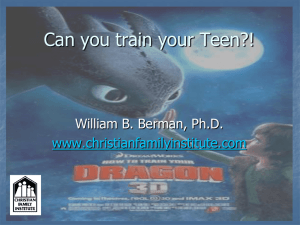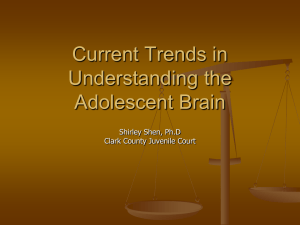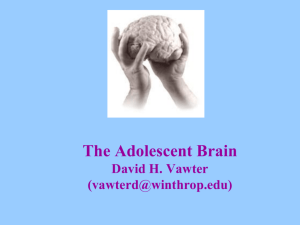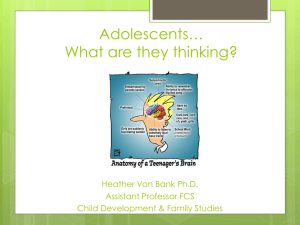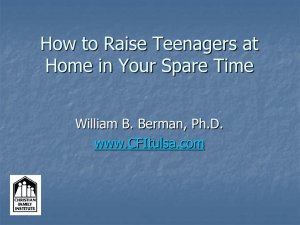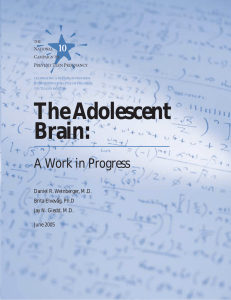Emotional Brain
advertisement
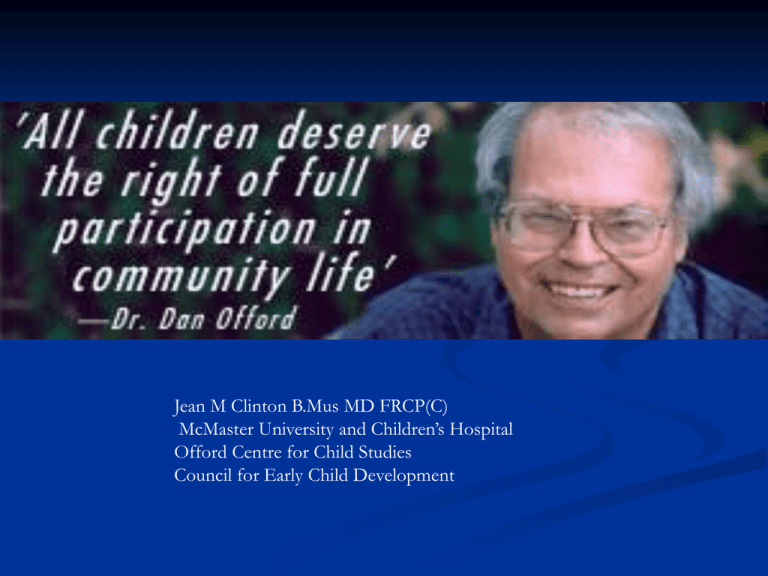
Jean M Clinton B.Mus MD FRCP(C) McMaster University and Children’s Hospital Offord Centre for Child Studies Council for Early Child Development Kids Today "The children now love luxury; they have bad manners, contempt for authority; they show disrespect for elders and love chatter in place of exercise. Children are now tyrants, not the servants of their households. They no longer rise when elders enter the room. They contradict their parents, chatter before company, gobble up dainties at the table, cross their legs, and tyrannize their teachers." PLATO Adolescents: Why DO they do the things they do? Defining Adolescence The period between the onset of sexual maturation & the attainment of adult roles & responsibilities Involves psychological, social, legal, and biological changes The transition from: “child” status (requires adult monitoring) to “adult” status (self-responsibility for behavior) Key Messages ‘UNDER CONSTRUCTION” Teens need MORE of our time, not less. What we THINK, affects how we FEEL, affects how we ACT (TAFFY) The majority of adolescents do well YET 03-013 THE BRAIN FAIRY The Hostage Brain , Bruce S. McEwen and Harold M. Schmeck, Jr., 1994. Adolescent Tasks Peer group formation Increased academic demands Pressure to be self-reliant (especially in two income families) Increased responsibility Money Romantic desires Identity formation What Changes in Adolescence? Memory and planning Responsibility Self-regulation or control of emotion Mood Lability Risk taking Sleep Why do we care about brain? YOU ARE YOUR BRAIN. BUT- Your brain is not just produced by your genes Your brain is sculpted by a lifetime of experiences. Dr Robin Gibb U of Lethbridge Anatomy of a teenager’s brain “The nerve cell, or neuron resembles a miniature tree…” (p. 21) Diamond & Hopson, 1998 SYNAPSE What Have We Learnt? • Adolescence is a period of profound brain maturation. • We thought brain development was complete by adolescence • We now know… maturation is not complete until about age 25! UNDER CONSTRUCTION Source: Giedd, 2004. Rate of Change Brain Development Source: Tapert & Schweinsburg, 2005 Brain Development When the pruning is complete, the brain is faster and more efficient. But… during the pruning process, the brain is not functioning optimally. Source: Giedd, 2004. Brain Development Maturation Occurs from Back to Front of the Brain Images of Brain Development in Healthy Youth (Ages 5 – 20) Blue represents maturing of brain areas Source: Gogtay, Giedd, et al., 2004. Copyright © 2004 The National Academy of Sciences, USA Gogtay, N., Giedd, J.N., et al. (2004) Dynamic mapping of human cortical development during childhood through early adulthood Proceedings of the National Academy of Sciences, 101 (21), 8174 – 8179 The Frontal Lobes “Executive Functions” Governing emotions Judgment Planning Organization Problem Solving Impulse Inhibition Abstraction Analysis/synthesis Self-awareness* Self-concept* Identity and Spirituality *Self- “everything” Williamsgroup, 2003: Please credit Protecting You/Protecting Me (PY/PM) AREAS UNDER CONSTRUCTION Prefrontal Cortex Responsible for planning , strategies (cognitive flexibility). Allows one to solve problems. DEVELOPED frontal cortex allows one to regulate emotions, solve problems effectively and plan behaviour. Frontal Lobes for Behavioral Control, Birth - 21 Age The Brain Bonsai Overproduction and Exuberance Pruning 02-066 The Fear Response Visual Thalamus Visual Cortex Amygdala Scientific American The Hidden Mind, 2002, Volume 12, Number 1 Hippocampus Amygdala Anterior Cingulate Cortex 03-002 Emotional Stimulus Amygdala + + Hippocampus Hypothalamus - - PVN Cortisol Cortisol CRF PIT ACTH Adrenal Cortex LeDoux, Synaptic Self Amygdala and Hippocampus 00-058 Cortisol can be bad for the brain Hippocampus high sterol levels cause loss of dendrites and cell death Frontal brain attention deficits WHAT YOU SEE IS WHAT YOU GET! Fear Contempt Disgust Surprise Sadness Anger Happiness What emotion do you see? Adolescents use the Amydala (fight or flight response) rather than the Frontal Cortex (used by older adults) to read emotions Deborah Yurgelun Todd McLean Hospital Belmont, Mass (2004) Limbic System for Birth - 21 Years Age Communication Gap Teens are more likely to misinterpret facial expressions of emotion See anger when there isn’t anger Process in the amygdala May react quickly “Emotional Brain” Development Emotional brain dominates Prefrontal cortex is not ready to take charge Emotional brain seeks pleasure, in the form of novelty, excitement, and risk What Does This Mean in terms of Behavior? Impulsiveness Mood changes Inadequate emotional control Seeks out risks ACC The “Oops Centre” Putting the brakes on, planning and regulating emotion develops with the final development of the frontal lobe at Around 20 -24 A fully pruned and sculpted frontal lobe HELPS (no guarantees) to resist the need to buy the first clothes you see or impulsively blow up in anger at your parent Made worse as group adolescent brains amp-up the levels Adolescents and Sleep Shift in Circadian (Biological Clock) to preferring later bedtimes and rise-times Need for sleep increases at puberty Societal influences push teens toward sleep delay Sleep deprivation common GREATEST OPPORTUNITY…GREATEST VULNERABILITY As the adolescent brain is reconfigured it is more susceptible to long lasting damage of drugs, alcohol, and negative experiences. Unfortunately, the brain is most vulnerable at a time when they are most inclined to take risks and to act impulsively…” (Jay Giedd, NIH 2004) Alcohol & Other Drugs Increase in dopamine which further encourages risk taking Increase in depression and anxiety Can wound or damage brain (more than in adults) Hinder brain storage of new information The Problem Frontal Lobe Development Autonomy drivers license Average age of first sexual encounter in Canada The Cognitive Affective Balance Early Adolescence Early Adulthood Ideally! KEY: Not the overall balance that matters, it is the flexibility to shift when needed Remember: the emotional brain is often in charge in teens. SCENARIOS What we THINK…. Affects what we FEEL… Affects how we ACT…. Provide Guidance and Opportunities Teens need to use their “thinking brains” for planning, analyzing, organizing, problem solving, and making decisions “ If we think we are fragile and broken, we will live a fragile, broken life. If we believe we are strong and wise, we will live with enthusiasm and courage. The way we name ourselves colors the way we live. Who we are is in our own eyes. We must be careful how we name ourselves.” Wayne Muller To see all individuals as “at promise” rather than “at risk” is a fundamental shift that means facilitating rather than fixing, pointing to health rather than dysfunction, turning away from limiting labels and diagnosis to wholeness and well-being. Key Messages ‘UNDER CONSTRUCTION” Teens need MORE of our time, not less. Parents are hugely important Their ACC picks up more than you emit… be genuine Dialogue works better than interview. What we THINK, affects how we FEEL, affects how we ACT (TAFFY) The majority of adolescents do well. In Closing: Brain development continues throughout life. The “emotional” brain shows earlier development than the “thinking” brain The “emotional” brain seeks novelty and stimulation, sometimes met by risky behavior Risks can be healthy and unhealthy Adults can and should provide guidance, opportunities, and environments that promote development of the “thinking” brain THRIVE The Canadian Centre for Positive Youth Development 1-800-265 2680 www.thrivecanada.ca The Search Institute www.search-institute.org Books and Resources The Primal Teen: What the new discoveries about the teenage brain tell us about our kids. Barbara Strauch New York Anchor Books 2003 “Why do they act that way.” A Survival Guide to the Adolescent Brain for you and Your Teen . David Walsh PhD New York Free Press 2004 Teen Brain, Teen Mind. What Parents Need to Know to Survive the Adolescent Years . Dr Ron Clavier Toronto Key Porter Books 2005 PBS Frontline (2003). Inside the Teenage Brain. www.pbs.org Giedd, J. (1999). Brain development during childhood and adolescence: A longitudinal MRI study. Nature Neuroscience, 2(10), 861-63 Carskadon, M. (2000). Adolescent sleep needs and patterns: Research report and resource guide. Washington, DC: National Sleep Foundation. www.sleepfoundation.org

